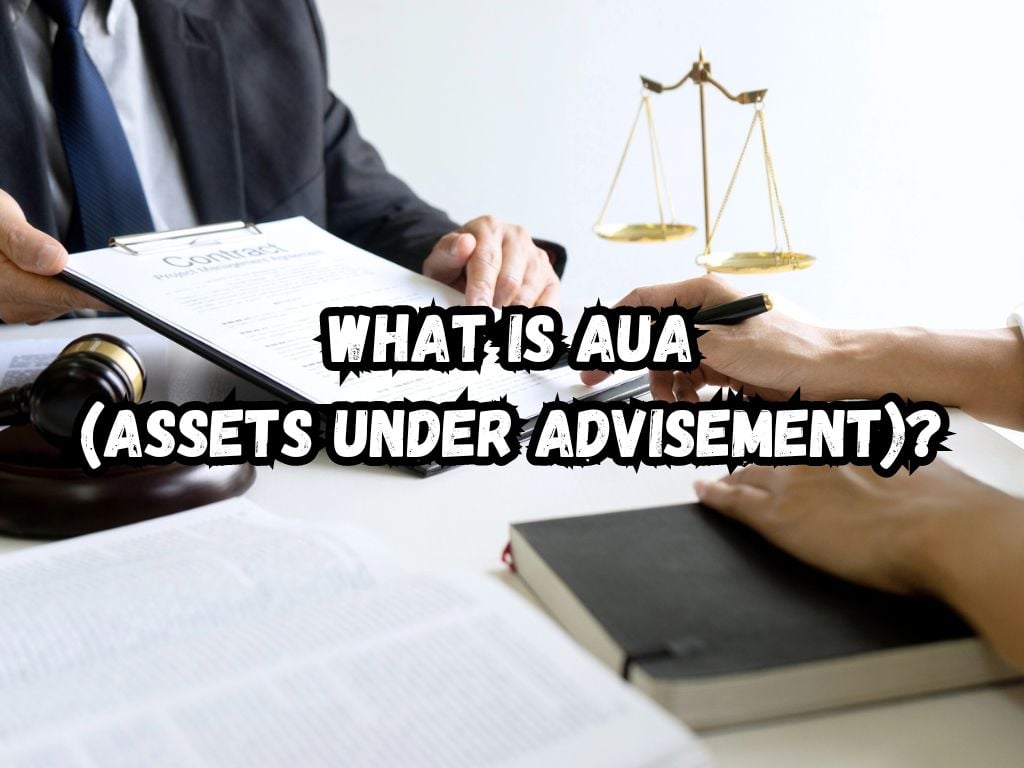If you’re an investor, you know there’s a wealth of terms and acronyms to know. One of these is Assets Under Advisement (AUA).
Knowing what AUA means plays an essential role in understanding how funds work. Its role in the financial world makes it a crucial term for investors and financial advisors.
What Is AUA (Assets Under Advisement)?
In the world of finance, Assets Under Advisement, AUA for short, refers to an investor’s total assets advised by a financial advisor.
AUA includes assets held with custodians or other entities under the advisor’s guidance. However, the advisor does not possess discretionary control over these assets.
Now, you might ask, isn’t it similar to Assets Under Management (AUM)? Yes and no. While both terms refer to the total assets a financial advisor oversees, there are significant differences. Advisors manage AUM directly.
They make decisions on buying or selling without needing the client’s approval each time. With AUA, advisors only provide advice. The client makes the final decision.
Additionally, you might encounter the term Assets Under Administration (AUA). In this scenario, certain organizations hold assets for investors without giving advice or making investment decisions.

The Significance of AUA for Investors and Advisors
AUA is more than just a financial term—it’s a measure of an advisor’s scope, experience, and potential influence in the investment sector.
High AUA could imply a high level of trust in an advisor. However, it’s essential to look at other factors, such as fees, client satisfaction, and the advisor’s history.
Advisors use AUA to gauge their business size and growth, how they stack up against competition, their compensation, and their market sector. Therefore, understanding AUA is beneficial for clients and advisors alike.
Calculating AUA
Calculating AUA is quite simple. It’s the sum total of all the advised assets. AUA doesn’t differentiate between asset types. Both liquid and non-liquid assets get counted the same.
Suppose you, as an investor, have three assets — a house, some stocks, and a 401(k) — all of which are under advisement. Your AUA would be the total monetary value of these assets.
AUA vs. Other Financial Measures
Perhaps the most common comparison made is between AUA and AUM. The AUM includes assets on which advisors can execute trades without always getting client approval. AUA refers to assets on which the advisor provides advice, but the client makes the final decision.
These differences prove critical when choosing an advisor or investment strategy. Understanding them can lead to more mindful investment decisions.
Maximizing Your Assets Under Advisement
Investors often ask how they might increase their AUA. While there’s no perfect formula, leveraging AUA comes down to smart decision-making.
The first step is to find an advisor who fits your needs. Once you become comfortable with your advisor’s strategies, you can confidently increase your investments.
Asking the right questions can maximize your AUA. Discussing what assets are appropriate for advisement, for example, can provide clarity.
The Future of AUA
In today’s digital age, technology is driving change in the financial sector, including AUA. More and more robo-advisors and advice platforms are offering these services.
As we move forward, we’ll likely see further changes driven by technology, regulatory shifts and evolving investor preferences.
INavigating AUA Risks and Challenges
Just as with any other investing strategy, managing Assets Under Advisement (AUA) is not without certain risks and challenges.
Understanding these potential risks is key to successfully navigating the investment landscape and effectively growing your portfolio.

Identifying Potential Risk Factors
Potential risk factors may not always be obvious and can stem from various sources. Numerous external influences — such as abrupt changes in market conditions, regulatory anomalies, and geopolitical uncertainties — can expose AUA investments to risk.
Internally, subpar financial advice or guidance based on erroneous or incomplete financial data can also impact the performance of your AUA investments.
Additionally, as AUA empowers the client with decision-making control, it inherently comes with the responsibility and attached risk of making potentially poor investment decisions.
For example, investors might face situations where their emotions or lack of knowledge could lead to unwise decisions that negatively impact their portfolios.
Proactive Approach to AUA Risks
Adopting a proactive approach to these challenges can help mitigate risks and optimize your investments.
First and foremost, it’s crucial to choose an advisor with a strong track record, good reputation, and comprehensive understanding of your financial goals and risk tolerance.
Staying informed and aligned with your advisor’s guidance is another key step. Regular communication ensures that you are up-to-date with your financial situation and investment strategies. This knowledge can be empowering, allowing you to make informed decisions confidently.
Ensure your investment portfolio is diversified, which can reduce the risk by spreading investments across various asset classes or sectors. A diversified portfolio is often more resilient to market fluctuations.
Finally, maintain a long-term perspective for your investments. Markets can be volatile in the short term, but historically, they tend to increase over the long haul.
Conclusion
Understanding Assets Under Advisement (AUA) is essential for investors as it strongly impacts the management of their financial portfolios. It influences how financial advisors guide their clients and how investment decisions are ultimately made.
A clear understanding and consistent overview of AUA enable investors to stay informed and aligned with their investment strategy.
With this knowledge, investors can actively participate in steering their investment journey, make informed decisions, and better manage potential risks.
Not only does this awareness empower investors to drive their financial stability and growth, but it also allows them to capitalize on opportunities and navigate economic cycles optimally.
In essence, a robust grasp of AUA is not just conducive—it is crucial in today’s complex financial landscape.


 Tags:
Tags:










